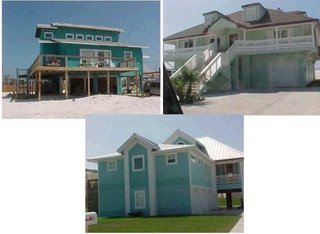 The county agency that governs Pensacola Beach is considering adopting a rule that would prohibit newly constructed or re-constructed homes from covering all of their pilings with break-away walls.
The county agency that governs Pensacola Beach is considering adopting a rule that would prohibit newly constructed or re-constructed homes from covering all of their pilings with break-away walls.Instead, the Santa Rosa Island Authority would impose an arbitrary limit of "850 square feet of enclosed space below the base flood elevation," according to Derek Pivnick's clear and succinct report in today's PNJ:
"Debbie Norton, the authority's Environmental and Developmental Services manager, said with fewer break-away walls, debris on the island could have been reduced by about one-third after Hurricane Ivan. Debris pickup after hurricanes is a great expense to the county, she said."Pivnick reports that Norton also claims "many beach homes had upper structure damage because their break-away walls didn't perform properly."
Island residents may be dubious about that latter claim unless Debbie can produce more eye witnesses than the property insurance industry has managed to find who can parse the sequence of structural destruction so many beach dwellings experienced during hurricanes Ivan and Dennis. Still, even if the Island Authority is inventing more excuses than it needs, the issue is a serious one. It's an old theme that has bedeviled the agency for a decade: how to enforce flood plain rules that prohibit ground floor "living space" in post-FIRM houses.
Memorably, that issue almost boiled over a few years ago when one resident raised a stink about a neighbor's ground-floor garage having been converted to living space. The neighbor denied the assertion. The accuser then demanded that a new inspection be conducted. Someone else then proposed that the board arm SRIA staff with the power to conduct surprise compliance inspections all over the place. The idea was quickly dropped after residents association representatives pointed out there were serious constitutional objections to warrantless home searches by government employees.
In past years, some SRIA staff privately estimated that at least a third and as many as half of all elevated homes and townhouses on the island had installed (after final inspection) forbidden plumbing, electrical, and other amenities to expand the livable area. The SRIA's concern about such a possibility is legitimate since under NFIP regulations local governments are accountable for enforcing national flood plain construction rules.
For too many years the old SRIA deliberately blinkered itself to such violations when it came to certain businesses, including a free-standing bicycle rental shop. But then news reached the island that FEMA was sending out threatening letters to municipalities which it had reason to think were deliberately failing to enforce flood plain 'livable space' rules. The letters pointed out that FEMA could void all flood insurance policies in the community if local government neglected its enforcement responsibilities. That got the SRIA's attention.
Ironically, however, the agency's concern about preventing over-building to cut down on storm debris seems to stop at the hotel lobby. Pivnick also reports that the SRIA is contemplating charging a "consideration fee" for commercial properties "that increase the number of hotel rooms or residential units from what was allowed on their original lease."
Until recently, county ordinances wisely imposed clear limits on so-called hotels that wanted to skirt the residential unit cap by converting short-term-stay hotel rooms into long-term condo units. Now, it looks like the SRIA is about to surrender on the issue entirely so long as the businesses pay "$3,030 for each additional unit" they aren't supposed to have.
To summarize: Island residents likely soon will be told they can't hide their pilings behind too many break-away walls, but commercial hosteleries will be able to buy their way around the residential building caps. Thus does the transmogrification of Pensacola Beach from a residential island paradise to a honky tonk hotel district continue apace.







No comments:
Post a Comment